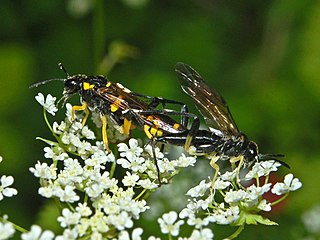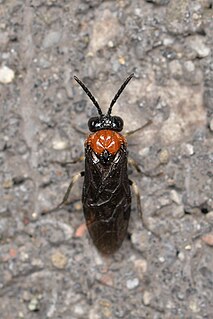
Apollonias is a genus of flowering plants belonging to the laurel family, Lauraceae. The genus includes from one to 10 species of evergreen trees and shrubs, depending on circumscription; recent studies have limited the genus to just one species, with the others transferred to Beilschmiedia.

Tenthredinidae is the largest family of sawflies, with well over 7,500 species worldwide, divided into 430 genera. Larvae are herbivores and typically feed on the foliage of trees and shrubs, with occasional exceptions that are leaf miners, stem borers, or gall makers. The larvae of externally feeding species resemble small caterpillars. As with all hymenopterans, common sawflies undergo complete metamorphosis.

Nectandra is a genus of plant in the family Lauraceae found in South America, and having fruit with various medical effects. Sweetwood is a common name for some plants in this genus.
Urbanodendron is a genus of flowering plants in the family Lauraceae. The three species are native to Brazil.
Sievert Allen Rohwer was an American entomologist who specialized in Hymenoptera. He was a graduate of the University of Colorado. At the time of his death, Rohwer was serving as the Coordinator Defense Activities for the Agricultural Research Administration within the U.S. Department of Agriculture. Rohwer worked for the USDA from 1909 until his death.

Byturidae, also known as Fruitworms, is a very small family of beetles, in the suborder Polyphaga, comprising fewer than 20 species worldwide. The larvae of some species develop in fruits. Byturus unicolor affects species of Rubus and Geum.
Aspidostemon is a genus of flowering plants belonging to the family Lauraceae. It occurs in Madagascar.
Rhodostemonodaphne is a genus of flowering plants in the family Lauraceae. It is a neotropical genus consisting of approximately 41 species occurring in Central America and northern South America. This genus has many species that are valued for timber. The classification of the genus is unclear since the species in the genus fall into a well-supported but unresolved clade that also includes species with unisexual flowers currently placed in the genera Endlicheria and part of Ocotea.

Tenthredo is a genus of sawflies with more than 700 species of the family Tenthredinidae, subfamily Tenthredininae. It is of Holarctic distribution.

Macrophya is a genus of sawfly.

Crabro is a genus of square-headed wasps belonging to the family Crabronidae. There are at least 80 described species in Crabro, found in the Nearctic and Palaearctic (Holarctic).
Pisonopsis is a genus of square-headed wasps in the family Crabronidae. There are about five described species in Pisonopsis.

Blennocampinae is a subfamily of common sawflies in the family Tenthredinidae. There are more than 100 genera and 600 described species in Blennocampinae.

Lestiphorus is a genus of sand wasps in the family Crabronidae. There are about 18 described species in Lestiphorus.

Stigmus is a genus of aphid wasps in the family Crabronidae. There are more than 20 described species in Stigmus.
Diploplectron is a genus of wasps in the family Crabronidae. There are more than 20 described species in Diploplectron.

Acordulecera is a genus of sawflies in the family Pergidae. There are more than 20 described species in Acordulecera.

Pontania is a genus of common sawflies in the family Tenthredinidae. There are more than 80 described species in Pontania.
Dineura is a genus of sawflies belonging to the family Tenthredinidae.
Stromboceros is a genus of insects belonging to the family Tenthredinidae.












